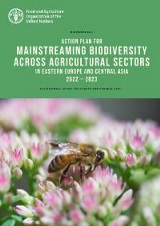No aspect on our planet is more complex, dynamic or rich than the layer of living organisms occupying our land and our oceans, and no element is more vital to global food production and essential for human well-being than the diversity of plants, animals and microbes and their environment. This diversity has been used and conserved by farmers and communities for millennia and remains a key element of the livelihood strategies of poor, small-scale farmers throughout the world.
Overview and FAO contribution
The world is made of an invisible web that we rarely recognize. Forests provide homes for animals. Animals eat plants. The plants need healthy soil to grow. Fungi help fertilize the soil. Bees and other insects carry pollen from one plant to another, enabling the plants to reproduce. The loss of species, whether animal or plant, weakens these connections and can alter the performance of an entire ecosystem.
FAO’s work on biodiversity aims at supporting countries in balancing the need to improve the food and nutrition security and livelihoods of the poor, especially in rural areas, while at the same time preventing the degradation, contamination and loss of natural resources while building resilience to climate change. To adapt to challenges and uncertainties, a large reservoir of biological diversity is needed.
Biodiversity is experiencing dramatic change and loss at the hands of humans. Unsustainable farming practices and systems, along with urbanization processes, are taking a terrible toll on our natural resources as we strive to meet a growing demand for food, feed and bioenergy. If left unchecked, the alarming pace of biodiversity loss will have devastating consequences for humankind.
Today, the world has some 821 million people suffering from chronic hunger. In addition, a quarter of our children younger than 5 are stunted, a third of the global population is malnourished, and obesity affects one in eight people on the planet. Conserving biodiversity and reducing the pressure on natural resources and ecosystems while mitigating the uncertainties associated with climate change have never been so important for our diets, our health and our survival.
Working closely with governments and key actors, FAO supports integrating sustainability in its three dimensions (social, economic and environmental) across agriculture, forestry and fisheries. Mainstreaming biodiversity; integrating landscape and seascape approaches into actions, policies and investments; and supporting farmers’ rights to genetic resources are key to building resilient livelihoods. Tapping into ecosystem services reduces the need for external inputs and improves efficiency.
Europe and Central Asia
The Europe and Central Asia (ECA) region includes four biodiversity hotspots (the Caucasus, the Irano-Anatolian region, the Mediterranean Basin and the mountains of Central Asia) and hosts a great variety of climates, landscapes, aquatic environments, soil types and cultures – and, hence, biodiversity. Being part of the primary centres of the origin of crop plants, the region is home to a great number of wild relatives of cultivated plants and domesticated animals.
Despite the lack of monitoring systems and reliable data, the loss of biodiversity for food and agriculture is a reality in the region. Rich biodiversity and diverse ecosystems are threatened by changes in land use and intensification in agricultural sectors. The narrowing of the genetic resource base affects the conservation and use of genetic resources for food and agriculture. Human activities are causing significant damage to marine and freshwater habitats and species, both through the discharge and runoff of nutrients and other chemicals and through direct physical contact or disturbance. Globally induced climate change increases the pressure on regional natural resources and ecosystem services, threatening biodiversity for food and agriculture. In Central Asian countries, the combination of excessive water use and limited water resources puts considerable stress on aquatic ecosystems and can jeopardize food production. Forest loss and the proliferation of invasive alien species also represent major global threats to regional biodiversity. The problem of genetic erosion caused by, inter alia, the steady trend of the replacement of local varieties with modern ones is common in the region.
The majority of the people in the region still live in rural areas. Agriculture plays an important role in people’s livelihoods and, due to its importance, is a major user of the region's natural resources. At the same time, smallholders and family farmers, livestock keepers, forest dwellers, fishers and fish farmers represent an important yet unexplored asset for the sustainable use, conservation, restoration and preservation of biodiversity for food and agriculture in the region. When managed by small-scale food producers, biodiversity can have a high level of heterogeneity embedded within it, thereby improving its adaptive capacity and increasing the resilience of ecosystems.
The future of our food systems depends on biodiversity
Publications
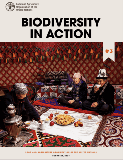
Biodiversity in Action — #3
2023
The third issue of Biodiversity in Action illustrates why the health of humans and the environment requires biodiversity and how all dimensions of food security depend on it, highlighting the risks for nutrition and health and the benefits for food and nutritional security.
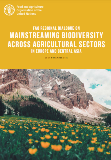
FAO regional dialogue on biodiversity mainstreaming across agricultural sectors in Europe and Central Asia.16–17 November 2021
2023
The objective of the Dialogue was to discuss challenges, exchange views and opportunities in addressing ways to mainstream biodiversity across agricultural sectors in Europe and Central Asia, promoting inclusive sustainable and resilient agri-food systems for improved food security and nutrition.
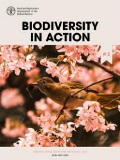
Biodiversity in action — #2
2023
Both climate change and biodiversity loss have distorting social and economic impacts on development and cause severe risks for food security, nutrition and livelihoods among rural populations in Europe and Central Asia, most of whom depend directly or indirectly on the agricultural sector.

News
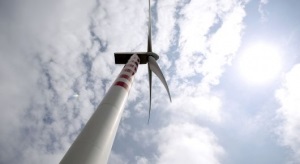
Green Climate Found Country Programme lays the foundations for transformative climate finance in North Macedonia
14/06/2022
Links
- FAO biodiversity
- FAO biodiversity mainstreaming platform
- International day for biological diversity
- Global dialogue on the role of food and agriculture in the post 2020 global biodiversity framework
- FAO's office of climate, biodiversity and environment
- Commission on genetic resources for food and agriculture
- International plant protection convention
- International treaty on plant genetic resources for food and agriculture
- Ecosystem services & biodiversity (ESB)
- The state of world' biodiversity for food and agriculture - Interactive Story
Events
- FAO regional dialogue on biodiversity mainstreaming across agricultural sectors in Europe and Central Asia 16-17 November 2021
- Recordings - day 1
- Recordings - day 2
Contacts
Tania Santivanez
Agricultural officer
Budapest, Hungary
Tel: +36 1 8141 240
Anna Kanshieva
Biodiversity Expert
Budapest, Hungary

